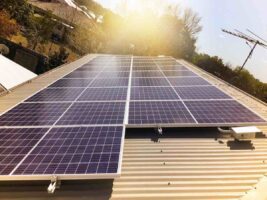Ever since the Copenhagen climate talks broke up in a haze of hot air and recrimination in late 2009, the United Nations has been keeping tabs on what the world says it wants to do and what it is actually doing.
It doesn’t make for pretty reading. What the UN found in its first “Emissions Gap Report” was a 10 gigatonne gap between rhetoric and action. That’s 10,000 million tonnes more greenhouse emissions than the world could afford. Two years later, that gap is now around 14 gigatonnes of C02e (carbon dioxide and equivalents).
The UN Environment Program released its latest Emissions Gap Report overnight, and drawing on the expertise of 51 scientists it repeats its earlier conclusions, that if the world is to achieve the stated common goal of limiting global average temperature rise to below 2 degrees Celsius this century, then global greenhouse gas emissions need to be no more than 44 GTC02e by 2020.
But they are currently heading for around 58 GtCO2e. Apart from a lack of global action, UNEP blames the increase on projected economic growth in key developing economies, and a phenomenon known as ‘double counting’ of emission offsets. It says emissions are currently 14 per cent above where they should be.
It is the third stark warning released in the past 10 days in the lead up to the annual climate change negotiations that resume next week in Doha – the world’s biggest emitter by capita. First, the International Energy Agency warned that two-thirds of the world’s fossil fuels will need to stay in the ground if such targets were to be met, then the World Bank highlighted the fact that the world was heading to average global temperatures rises of 4°C – and devastating consequences – on current trajectories. And yesterday, the World Meteorological Organisation report, revealed that greenhouse gas emissions reached record levels in 2011.
The UNEP report focuses on two principal avenues to close the gap, and both have implications for Australia, particularly given the structure of its carbon price and its stance in international climate talks.
The first is implementing the more ambitious “conditional” pledges made at Copenhagen, and upheld in Cancun and Durban. Australia is involved here because it has a range of emissions reductions target from its current 5 per cent below 2000 levels to a maximum 20 per cent, depending on what everyone else does. UNEP says this could save 2 GtCO2e.
UNEP also wants to minimise the use of “lenient” land use, land use change and forestry credits and surpluses. This mostly affects nations such as Canada and Russia, but Australia – thanks to the so-called Australia clause – in Kyoto, is also a major beneficiary. This accounts for 3.2 GtCO2e in total.
UNEP also wants to minimise the use of surplus credits from the first period of the Kyoto protocol (1.8GTCO2e). Once again, Australia is involved here because the carryover of its credits is a condition – along with the Australia clause – of its participation in a second commitment period of Kyoto. Although this is seen as largely symbolic, it is a critical part of the negotiation process.
And finally, UNEP wants a significant tightening of the rules for projects developed under the Clean Development Mechanism, the international carbon market which Australia is using to source 15 per cent of its liabilities. UNEP says there is double counting of some offsets and some projects are not “additional” – meaning that they do not reduce any more emissions than would have occurred. It says tightening these rules will cut emissions by 1.5GTCO2e.
This table below shows where UNEP thinks that the gigatonne gap can be bridged.
This report shows that the estimated emissions gap in 2020 for a “likely” chance of staying below the 2°C target is large, but it is still technically possible to close this gap through concerted and rapid action.
As it notes, improved energy efficiency in industry could deliver cuts of between 1.5 to 4.6 Gt of CO2 equivalent; followed by agriculture, 1.1 to 4.3 Gt; forestry 1.3 to 4.2 Gt; the power sector, 2.2 to 3.9 Gt; buildings 1.4 to 2.9 Gt; transportation including shipping and aviation 1.7 to 2.5 Gt and the waste sector around 0.8 Gt.
But it says that certain measures, such as energy efficiency in buildings, could deliver average reductions of around 2.1 Gt by 2020 but cuts of over 9Gt CO2 equivalent by 2050. This would mean that the building sector in 2050 could consume 30 per cent less electricity than in 2005, despite more than doubling in surface area. This, though, would require “state of the art building codes may need to become mandatory in the next 10 years in all of the major economies such as the US, India, China and the EU, and further reductions from more energy-efficient appliances and lighting systems.
Interestingly, despite disappointing progress for power plant efficiency, nuclear and carbon capture, UNEP notes that one major positive is the rollout of renewables, and the surprising cost gains made by solar PV. It noted that solar PV technology costs are now 76 per cent below their level of just four years ago, and the LCOE (levellised cost of energy) was now between $100 and $260 a megawatt-hour (MWh). It was now possible that installed capacity of solar PV could rise by 500GW out to 2020, which would help ensure that at least renewables were pulling their weight.
Achim Steiner, UN Under-Secretary General and UNEP Executive Director insists that bridging the gap remains “doable” with existing technologies and policies, and there has been much progress in building energy efficiency, investments in forestry and vehicle emissions standards, as well as the investment in renewables.
“Yet the sobering fact remains that a transition to a low-carbon, inclusive green economy is happening far too slowly and the opportunity for meeting the 44Gt target is narrowing annually,” he added.
Sadly, though, there is now a growing conclusion in business circles that it is all too hard. The global consulting group PwC has just issued the latest update of its annual low-carbon economy index, and suggests that business people might be best advised to prepare for a warmer world – adaptation rather than mitigation – even though all the research tells us this is the most expensive route.
PwC said the required improvement in global carbon intensity to meet a 2ºC warming target has risen to 5.1 per cent a year, from now to 2050. “We have passed a critical threshold – not once since 1950 has the world achieved that rate of decarbonisation in a single year, but the task now confronting us is to achieve it for 39 consecutive years,” it wrote.
The 2011 rate of improvement in carbon intensity was 0.8 per cent. Even doubling our rate of decarbonisation, would still lead to emissions consistent with 6ºC of warming. “To give ourselves a more than 50% chance of avoiding two degrees will require a six-fold improvement in our rate of decarbonisation,” it concluded. “Now one thing is clear: businesses, governments and communities across the world need to plan for a warming world – not just 2ºC, but 4ºC and, at our current rates, 6ºC.”








